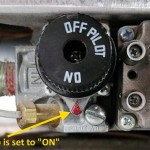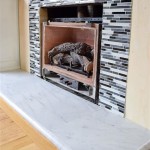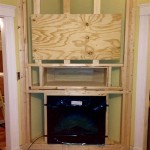Hiding TV Cords Over a Fireplace: A Practical Guide
Mounting a television above a fireplace has become increasingly popular, offering a focal point for entertainment in living spaces. However, the aesthetic appeal of a large screen can be diminished by unsightly cords dangling down the wall. Effectively concealing these cords is crucial for achieving a clean and professional look. This article explores various methods for hiding television cords when mounting a TV above a fireplace, balancing visual appeal with practical considerations.
The presence of a fireplace introduces unique challenges for cable management. Heat from the fireplace, even a gas fireplace, can pose a risk to cords, particularly those not rated for high temperatures. Moreover, different fireplace constructions (brick, drywall, stone) require different approaches to hiding cables. Planning and proper execution are essential to avoid damage to the wall, the TV, or the fireplace itself.
Understanding the Challenges and Considerations
Before embarking on any cord-hiding project, it is important to assess the existing infrastructure and potential limitations. The primary challenge is safely routing the cords from the TV to the power outlet and cable/satellite box, usually located below the fireplace. Consider the following factors:
Wall Material: Is your wall constructed of drywall, brick, stone, or a combination of materials? Drywall is the easiest to work with, allowing for the installation of in-wall cable management systems. Brick and stone require more specialized tools and techniques, often involving surface-mounted solutions.
Fireplace Type and Heat Output: Determine the type of fireplace (gas, electric, or wood-burning) and its approximate heat output. This will influence the choice of cable routing and the need for heat-resistant cable sleeving or conduit. Avoid running cables directly behind a wood-burning fireplace due to the intense heat.
Electrical Code Compliance: Ensure that any electrical work, including the installation of a new outlet behind the TV, complies with local electrical codes. It is advisable to consult with a qualified electrician to ensure safety and compliance.
Future Accessibility: Think about future access to the cables. Technology changes, and you may need to upgrade or replace cables in the future. Choose a method that allows for relatively easy access without extensive demolition or reconstruction.
In-Wall Cable Management Kits
For drywall walls, in-wall cable management kits offer a clean and concealed solution. These kits typically include two plastic grommets or boxes, one installed behind the TV and the other near the power outlet and cable box. A hole saw is used to create openings in the drywall, and the grommets are inserted to provide a finished look. Cables are then routed through the wall cavity between the grommets.
Advantages: Provides a completely hidden solution, eliminating visible cords. Relatively easy to install in drywall. Offers a professional and aesthetically pleasing result.
Disadvantages: Not suitable for brick or stone walls. Requires cutting into the drywall. Potential for difficulty routing cables through insulation or framing members within the wall. Care must be taken to avoid electrical wiring or plumbing within the wall cavity.
When installing an in-wall cable management kit, use a stud finder to locate wall studs and avoid cutting into them. Consider using a fish tape or wire to guide the cables through the wall cavity. Secure the cables with cable ties or clips to prevent them from dangling and potentially interfering with other objects inside the wall.
Surface-Mounted Cord Covers
For brick, stone, or situations where in-wall installation is not feasible, surface-mounted cord covers provide an alternative solution. These covers are typically made of plastic or metal and are designed to conceal cords along the surface of the wall. They are available in various sizes, colors, and styles to blend with the existing décor.
Advantages: Can be used on any type of wall surface. Easy to install using adhesive tape or screws. Provides a clean and organized appearance. Allows for easy access to cables for future changes or repairs.
Disadvantages: Cables are still visible, albeit concealed within a cover. Can be less aesthetically pleasing than in-wall solutions. May require painting or staining to match the wall color.
When selecting surface-mounted cord covers, choose a size that can accommodate all the necessary cables. Consider the color and style of the covers to ensure they blend seamlessly with the wall. Use adhesive tape or screws to securely attach the covers to the wall, ensuring they are aligned properly and evenly spaced.
Using Furniture and Décor
In some cases, furniture and décor can be strategically used to conceal cords. A console table or entertainment center placed below the fireplace can serve as a hiding place for the cable box and other components, minimizing the need for extensive cable routing. Decorative items such as plants, picture frames, or wall art can also be used to strategically obscure cords.
Advantages: Cost-effective and easy to implement. Minimizes the need for drilling or cutting into the wall. Allows for flexibility in rearranging furniture and décor.
Disadvantages: May not be suitable for all room layouts. Requires careful planning and placement of furniture and décor. May not completely conceal all cords.
When using furniture and décor to hide cords, consider the overall aesthetic of the room and ensure that the chosen items complement the existing décor. Arrange furniture in a way that minimizes the visibility of cords and provides easy access to the cable box and other components. Use cable ties or clips to organize and bundle cords, preventing them from becoming tangled or unsightly.
Regardless of the method chosen, prioritizing safety is paramount. Ensure that all electrical connections are secure and that cords are not exposed to excessive heat or moisture. Regularly inspect cords for damage and replace them if necessary. By carefully planning and executing the cord-hiding project, the television above the fireplace can become a stylish and functional focal point in the living space.

How To Hide Tv Wires Above A Fireplace When You Can T Go Through The Wall Homes I Have Made

Hide Cords Of A Tv Mounted Over Fireplace Powerbridge

Tv Wall Mount Installation With Wire Concealment Over Fireplace

How To Hide Tv Wires Above A Fireplace When You Can T Go Through The Wall Homes I Have Made

How To Hide Cable Wires When Mounting Tv Over Fireplace Hometalk

Learn How To Hide Tv Wires In A Wall Julie Blanner

How To Hide Wall Mounted Tv Cords Above A Fireplace Without An Electrician Over

How To Hide Electronics On A Mantel

How To Hide Tv Wires Above A Fireplace When You Can T Go Through The Wall Homes I Have Made

Tv Wall Mount Installation With Wire Concealment Over Fireplace








